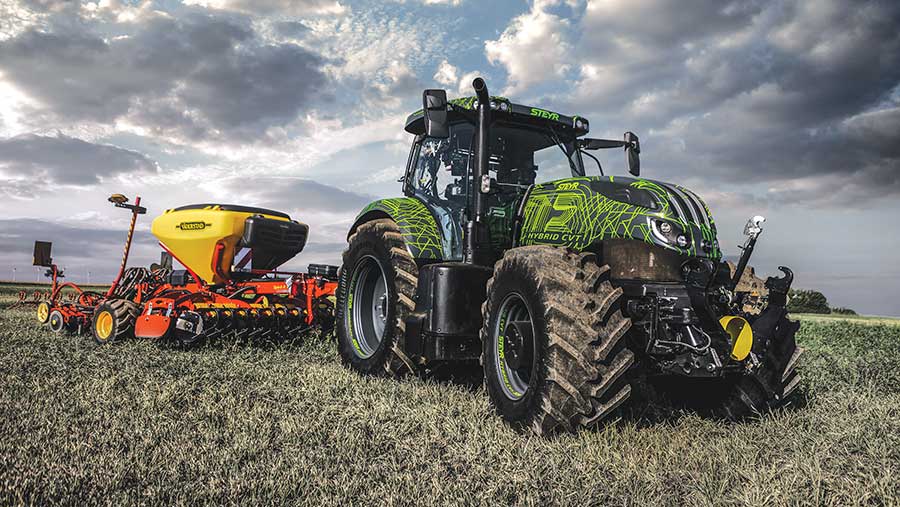Novel hybrid tractor drivetrain developed by CNH brand Steyr
 © Steyr
© Steyr Any Formula 1 fan will be used to seeing its high-performance cars harvesting unused energy and deploying it as a tactical power boost further down the track.
Farmers could be doing a very similar thing in the field soon, as Austrian tractor maker Steyr revealed the first fully operational hybrid tractor at a recent press briefing in Austria.
The company debuted the hybrid tractor concept at the Agritechnica show in 2019 and was due to reveal its hybrid transmission design at the following event in 2021 before the pandemic forced its cancellation.
See also: JCB’s hydrogen-fuelled combustion engine examined
Now production ready, the Steyr Hybrid is based on the firm’s 180hp 6175 Impuls CVT, which has a hydro-mechanical continuously variable transmission on the rear half of the drivetrain.
This is combined with a hybrid-electric module on the front axle, resulting in the tractor’s permanently available peak horsepower boosted to 260hp in what is a very light and nimble frame.
Supercapacitors
The hybrid system itself consists of an electric generator and electric motor. The tractor also has a bank of supercapacitors that store energy, which would otherwise be wasted, for later use.
Power generated by the hybrid system can then be combined with the conventional hydro-mechanical drive on demand through a smart four-wheel drive clutch.
Steyr says there are several advantages provided by the hybrid technology, the first of which is its E-CVT feature.
This can propel the tractor solely using the hybrid-electric system, drawing about 75kW of engine power at 1,100rpm, while the rest is directed to a pto-driven implement.
During an operation that demands non-consistent pto loads, the E-CVT results in a much smoother and comfortable ride, and significant fuel savings.
E-Shuttling offers seamless and more responsive directional change, with high-torque instantly available from the electric motor at low engine speeds.
This means less time stationary and 41% faster manoeuvring, again offering fuel savings of 15% for loader work, the company says.
Having instant torque on tap is advantageous in the field and on the road, with E-Boost helping to get the tractor up to speed when pulling away from junctions or after slowing for roundabouts with a heavy towing load.
Going downhill, E-Braking helps keep a constant speed and uses the electric drive like a retarder on a truck, minimising brake wear and increasing safety.
E-Steering uses the power to accelerate the front axle when turning in the field, which reduces turning radius by 15% and increases manoeuvring speed by 20%.
When four-wheel drive is engaged, E-Torque Vectoring directs torque to the front or rear wheels when required, meaning that traction is optimised by running axles at the same speed rather than the front running 3-5% faster.
Fuel savings, reduced tyre wear and less soil and crop damage are advantages, plus four-wheel drive can be used on the road without risk of damage or a rough ride.
Speed variation in the field when cultivating through tough spots can also be reduced by 6% with E-Torque filling, increasing work rates, while the E-Eco mode combines electric and conventional drive during light work to use as little fuel as possible.
The Hybrid CVT’s system can provide up to 75kW at 700V via a standard AEF port to electrified implements, powering their various functions and the wheels of driven trailer axles, for example.
Coming soon
Steyr would not provide an exact date for the start of commercial production but hopes it will be available ahead of Agritechnica 2025.
Although the development and pre-production models have been Steyr branded, the technology is fully transferrable, and it is likely other brands in the CNH group will offer hybrids as well. It is also scalable to higher horsepower machines.
Asked if the technology will become the norm, Markus Putz of Steyr said he believed it likely to be a popular option among current buyers of the highest spec, cutting-edge tractors.
“The technology is flexible and there is potential to save fuel if you stabilise the engine speed at a point that you can’t with a conventional transmission.
“We will also see more and more electrified implements and we think the combination [with a hybrid tractor] could work well,” he concludes.

